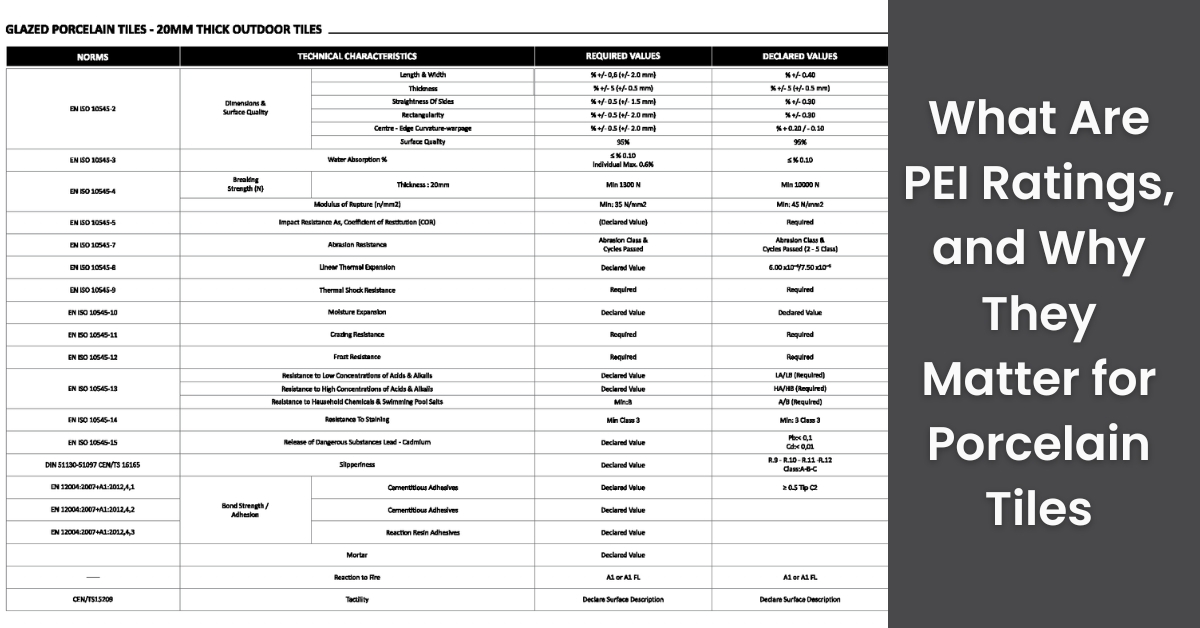When selecting porcelain tiles for your home or commercial space, it’s essential to understand the PEI rating. The PEI (Porcelain Enamel Institute) rating measures a tile’s durability and resistance to abrasion, helping you choose the right tile for different levels of foot traffic and use. PEI ratings play a crucial role in ensuring that your tile selection matches the demands of each space, from high-traffic areas like kitchens and entryways to low-traffic areas like bedrooms.
In this guide, we’ll explain what PEI ratings are, why they matter, and how to use them when selecting porcelain tiles. We’ll also include a comparison table to highlight each PEI rating level and its ideal applications.
What Is the PEI Rating?
The PEI rating system was developed by the Porcelain Enamel Institute to measure the durability and abrasion resistance of glazed tiles, specifically how well they stand up to foot traffic and wear. PEI ratings range from 0 to 5, with each level indicating the tile’s suitability for different applications based on foot traffic.
- PEI 0: Not suitable for any foot traffic; typically used for wall tiles only.
- PEI 1: Suitable for very light foot traffic, such as bathroom walls or decorative tiles.
- PEI 2: Suitable for areas with light foot traffic, such as residential bathrooms or bedrooms.
- PEI 3: Suitable for moderate foot traffic, making it ideal for most residential applications.
- PEI 4: Suitable for heavy foot traffic, including commercial spaces and high-traffic residential areas like kitchens and hallways.
- PEI 5: Suitable for very heavy foot traffic, typically used in commercial or industrial areas.
Why Do PEI Ratings Matter for Porcelain Tiles?
Understanding the PEI rating is crucial for selecting tiles that will last and perform well in their intended environment. Using the wrong PEI rating could result in premature wear, scratches, and even cracking, which can be costly to repair or replace. Here’s why PEI ratings are essential:
- Durability: The PEI rating ensures that you choose a tile with the right level of durability for the amount of wear it will experience.
- Cost-Effectiveness: By selecting a tile with an appropriate PEI rating, you can avoid excessive maintenance and replacement costs.
- Appearance Maintenance: Higher PEI-rated tiles resist scratches and abrasions better, helping your floors look new longer.
- Safety: Using tiles with the proper durability in high-traffic areas prevents cracking or other structural issues that could become hazardous.
PEI Rating Levels and Their Ideal Applications
To help you understand which PEI rating is suitable for various spaces, here’s a breakdown of each rating level and its recommended applications.
| PEI Rating | Durability | Best Applications | Recommended Use |
|---|---|---|---|
| PEI 0 | No foot traffic | Wall tiles only, decorative tiles | Ideal for accent walls, backsplash |
| PEI 1 | Very light foot traffic | Bathroom walls, low-use areas | Decorative areas, indoor walls |
| PEI 2 | Light foot traffic | Residential bathrooms, low-traffic rooms | Best for powder rooms, bedroom floors |
| PEI 3 | Moderate foot traffic | Residential kitchens, living rooms | Suitable for most residential applications |
| PEI 4 | Heavy foot traffic | High-traffic residential and light commercial | Ideal for kitchens, entryways, office floors |
| PEI 5 | Very heavy foot traffic | Commercial, industrial spaces | High-traffic areas, retail stores, public spaces |
In-Depth Look at Each PEI Rating
- PEI 0: These tiles are intended solely for walls and decorative features. They are not suitable for flooring, as they cannot withstand any foot traffic.
- PEI 1: Tiles with a PEI 1 rating are suited to areas with very light or no foot traffic. They are often used in residential bathrooms for walls and decorative accents but should not be installed on floors.
- PEI 2: With a PEI rating of 2, these tiles can handle light foot traffic and are best for low-traffic residential areas such as bathroom floors, bedroom floors, or walls in any room. They are not ideal for kitchens, entryways, or other areas with moderate or heavy traffic.
- PEI 3: PEI 3 tiles are a versatile choice for most residential settings, as they can withstand moderate foot traffic. These tiles are suitable for living rooms, kitchens, dining rooms, and entryways in residential homes.
- PEI 4: This rating signifies tiles that can handle heavy foot traffic, making them suitable for both residential and light commercial use. PEI 4 tiles are an excellent choice for high-traffic areas, such as kitchens, hallways, and office spaces.
- PEI 5: The highest PEI rating, PEI 5 tiles are designed to withstand very heavy foot traffic. They are suitable for commercial and industrial spaces where floors experience constant use, such as retail stores, shopping centers, airports, and other public spaces.
Choosing the Right PEI Rating for Your Space
Here are a few tips to help you select the best PEI rating based on your specific needs:
- Identify the Room’s Traffic Level: Consider the amount of foot traffic the tile will experience. For example, a low-traffic bathroom can use PEI 2 tiles, while a busy kitchen or hallway may require PEI 4 or even PEI 5.
- Consider Maintenance Requirements: Higher PEI-rated tiles tend to be more resistant to scratches and staining, which means they require less maintenance over time.
- Think About Cost vs. Durability: While higher PEI-rated tiles may cost more initially, their durability can provide a better long-term investment, especially in high-traffic areas.
- Assess Aesthetic Needs: Some styles, colors, and finishes may only be available in specific PEI ratings, so ensure the tile’s design also meets your aesthetic preferences.
Pros and Cons of High and Low PEI Ratings
Higher PEI Ratings (4-5)
- Pros:
- Extremely durable, ideal for high-traffic and commercial spaces
- Resistant to scratches, stains, and abrasions
- Low maintenance and longer-lasting
- Cons:
- More expensive
- Often limited in style for residential settings, as some high-PEI tiles are designed for commercial use
Lower PEI Ratings (1-3)
- Pros:
- More affordable
- Wide range of styles, colors, and designs for residential use
- Easier to install, especially for DIY projects
- Cons:
- Less durable, limited to low-traffic areas
- Not suitable for areas exposed to heavy foot traffic or wear
Frequently Asked Questions
Q1: Can I use a PEI 3 tile in a commercial setting?
While PEI 3 tiles are suitable for most residential areas, they may not hold up well in a commercial setting with heavy foot traffic. For commercial spaces, it’s best to choose PEI 4 or 5.
Q2: Are PEI ratings applicable to all types of tiles?
PEI ratings specifically apply to glazed ceramic and porcelain tiles. Natural stone tiles, unglazed tiles, or certain other tile materials may not carry PEI ratings.
Q3: Do higher PEI ratings mean the tile is more expensive?
Generally, yes. Higher PEI-rated tiles are often more costly due to their enhanced durability and the more robust manufacturing process. However, they can offer greater longevity, making them a worthwhile investment for high-traffic areas.
Conclusion
Understanding PEI ratings is essential for selecting the right tile for each area of your space. The PEI rating helps ensure that the tile you choose meets the durability requirements for its intended use, whether it’s a low-traffic bathroom, a high-traffic kitchen, or a commercial lobby. By choosing tiles with the appropriate PEI rating, you can enhance the longevity, appearance, and safety of your floors, avoiding costly repairs or replacements in the future.
For expert assistance in selecting the best PEI-rated porcelain tiles for your specific project, contact us to explore options tailored to both residential and commercial applications.
For inquiries, reach us directly:
- Email: info@rinisun.com
- Phone & WhatsApp: +91 9016222292
Let Rinisun Tiles guide you in choosing tiles that offer long-lasting performance and visual appeal for any space, from high-traffic commercial areas to cozy residential rooms.



